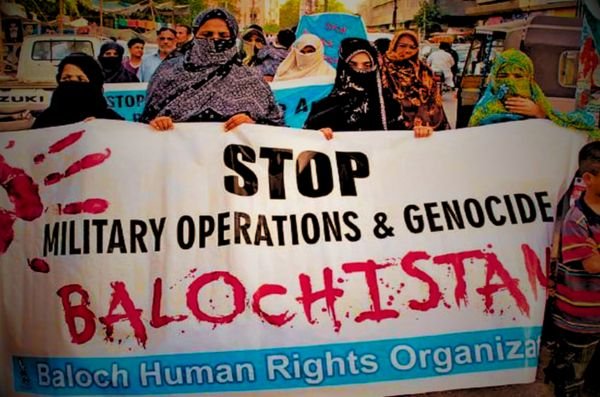
Baloch national Leaders declared independence from Pakistan and proclaimed the formation of “Democratic Republic of Balochistan.”
The movement got attention from all over the world after surfacing the Baloch Liberation Army, Republic of Balochistan, Balochistan Independence on social media platforms.
These people asked the United Nations for recognition and intervention. They also requested for deployment of peacekeeping forces in the region.
The people from Balochistan urged India for recognition as an independent state and to establish the official Embassy of Balochistan in New Delhi.
These current developments in Pakistan exposed the reality of Pakistan. They revealed the deep-seated grievances of the Baloch people regarding political marginalization, economic exploitation, and human rights abuses by the Pakistani state.
But this is not a new issue for Pakistan. They were already present in the country and were being suppressed using brutal forces and military might by Pakistan. These people have been fighting for a very long time for independence.
This long history of grievances, including human rights abuses and military crackdowns have fueled the current push for sovereignty and the appeal for international recognition from Balochistan.
Originally Balochistan was part of the princely state of Kalat. It had declared independence on 11th August 1947, when the British left the subcontinent. Later, it was annexed by Pakistan in 1948 under contentious circumstances.
But that annexation led to many insurgencies and protests against that forced integration. They are still active in the region under Baloch nationalists leadership.
People of Balochistan do not consider themselves Pakistani, they believe that Baloch are not Pakistan’s people. They have been forcefully merged into Pakistan which has led to erosion of autonomy of Balochistan.
Since the forced integration of Balochistan, Baloch people have faced exploitation of resources, loss of identity, military crackdowns, enforced disappearances, extrajudicial killings and suppression from Pakistan.
Notable incidents such as the 2006 killing of Nawab Akbar Bugti, a prominent Baloch leader, and the recent death of Tariq Baloch, a renowned car racer, allegedly under Pakistan’s “kill and dump” policy, have created more tensions in the region.
Mass graves discovered in several districts have further deepened public anger and suspicion of state-led violence.
It reflects growing public frustration and determination among the Baloch people, who feel their grievances have been ignored by the Pakistani government.
Therefore numerous activists groups and organizations already have been fighting for the freedom of Balochistan. And Pakistan had been crushing these uprisings and resistance with military crackdowns.
But recent changes and developments are showing the struggles and hurdles of the People from Balochistan.
The Baloch Liberation Army (BLA) has emerged as a key player in the armed struggle. It’s a militant organization fighting for the freedom of Balochistan.
In March 2025, the BLA hijacked the Jaffar Express, holding over 450 passengers hostage to demand the release of Baloch political prisoners.
Again in May 2025, the BLA claimed responsibility for 71 attacks across 51 locations under “Operation Herof,” targeting Pakistani infrastructure and security forces.
These actions have drawn global attention to the Baloch cause and it is spreading all over the world.
For the Baloch people, this is a fight for survival, rooted in decades of oppression, and mistreatment by Pakistan.
If we observe the Landscape of Pakistan, we will find that Pakistan is divided into four different regions namely Khyber Pakhtunkhwa, Punjab, Sindh and Balochistan.
Among them, Balochistan is the largest province of Pakistan. It covers 44 percent of total territorial land. The region is mostly dominated by Baloch ethnic population.
More importantly, it is the wealthiest land of Pakistan in terms of natural resources including natural gas from the Sui gas fields, copper, gold, and untapped minerals. It is called the “fruit basket of Pakistan” because the region produces much of Pakistan’s fruits and nuts.
Despite being a resource rich region, Balochistan is the least developed and poorest region of the pakistan. The Locals have always faced social, economical and political discrimination for a very long time.
China-Pakistan Economic Corridor (CPEC) , a flagship project of China’s Belt and Road Initiative, passes through the Gwadar Port. Under this China gets direct access to the Indian Ocean, bypassing the Strait of Malacca. The region is a key driver of Pakistan’s economy.
Additionally, the Gwadar Port is located in that region which is the economic power House of the Pakistani Economy. The province’s 770-km vast coastline along the Arabian Sea makes it geopolitically significant for Pakistan.
But people from Balochistan believe that their natural resources and lands are being exploited by Pakistan benefiting China and Pakistan. And the people of Balochistan are not getting benefits from these developments in the region.
Therefore the Baloch people feel cheated and ultimately these factors are fueling deep resentment among Baloch people, leading to political instability in the region.
